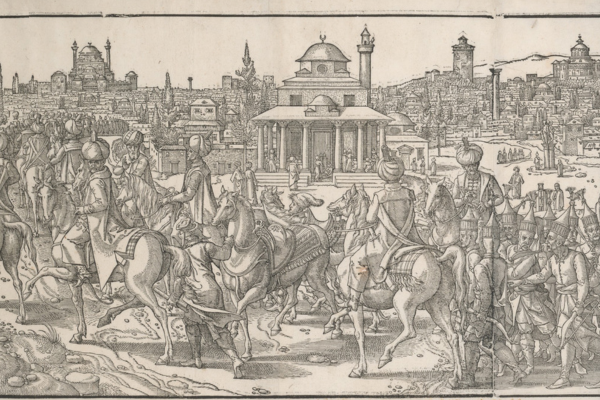
Kaya Şahin, Vice Provost for Global Strategies and International Affairs will present "Public Ceremonies in the Ottoman Empire, ca. 1450-ca. 1580" as part of the CMRS Colloquium Series.
In this talk, Dr. Şahin will discuss public ceremonies organized by the Ottoman palace between 1457 and 1582. These ceremonies allow us to discuss the origins and contents of Ottoman ceremonial culture, which borrowed themes and motifs from the Byzantines, the Venetians, and the myriad Turko-Muslim polities with whom the Ottomans maintained intense diplomatic and cultural relations. They also show how, in early modern societies, public ceremonies served as instruments of governance by creating highly visible, memorable, and relatively participatory events, and by constituting new spaces for political and cultural interactions.
Kaya Şahin is Professor of History and the Vice Provost for International Affairs and Global Strategies at the Ohio State University. After receiving his PhD in History from the University of Chicago, he taught at Northwestern, Tulane, and Indiana. He is the author of Empire and Power in the Reign of Süleyman: Narrating the Sixteenth-Century Ottoman Empire and Peerless among Princes: The Life and Times of Sultan Süleyman. He published articles on apocalypticism, bureuacracy, early modern Orientalism, crosscultural encounters, and ceremonies and rituals. He is currently working on a new book, provisionally entitled Empire, Ritual, Masculinity: Circumcision Celebrations for Ottoman Princes, 1457-1582.
This event is free and open to the public.
Page of Research: Public Ceremonies in the Ottoman Empire, ca. 1450-ca. 1580.
Kaya Şahin, OSU Department of History
Following the conquest of Constantinople in 1453, and especially during the first decades of the sixteenth century, the Ottoman polity was transformed from a late medieval kingdom into an early modern empire. The empire’s territory increased nearly threefold between 1450 and 1550. It extended from Central Europe and North Africa in the west to Iran in the east, and from the Crimean Peninsula in the north to Abyssinia and the Persian Gulf in the south. Ottoman imperial ideology was reshaped as a universalist narrative that promised peace and prosperity to Muslims and non-Muslims alike, under the supreme religio-political authority of the Ottoman sultan. The ruling elite became more professionalized, as well as more numerous. Constantinople, the Ottoman capital after 1453, saw its population increase from 20,000 at the time of the conquest to half a million by the late 1500s. The city’s Muslim and non-Muslim artisans and merchants, its vibrant religious confraternities, its growing underclass of unemployed and itinerants of all stripes, and the members of the resident janissary army formed a dynamic urban constituency.
In this period, several events were transformed into public ceremonies, including royal weddings and circumcisions, military parades, the sultan’s entries into conquered cities, the reception of diplomats, the public punishment of criminals, and religious processions. The new public ceremonies forged a strong political and cultural link between the sultan and the subjects and became integral components of Ottoman governance. Constantinople was turned into a stage on which the empire’s past and present, and the identity of the empire’s various constituents, were performed.
All early modern polities exhibit a surge in the development of their bureaucratic capabilities, but these capabilities were limited by the level of negotiation between the center and other powerful groups, the geographical size of the realm, and the natural environment. Public ceremonies provided spaces of contact and negotiation, and helped create a semblance of governance in environments where the relations between the authorities and the subjects might be either non-existent or delicate. Related to this, public ceremonies exposed the symbolic and performative aspects of power in an early modern society. Patronage and loyalty had to be re-established frequently, against the presumptions of modern scholars who often described early modern political cultures as conservative, non-dynamic, and dominated by monarchs and the elite. While bureaucratic forms of governance established a clear demarcation between the ruler and the ruled, ceremonies offered narratives whereby the ruler, the elite, and the subjects belonged to the same cultural system, within prescribed hierarchies that were both deployed and tested performatively.
Together with other loci of social interaction such as the marketplace, the coffeehouse, and the religious/devotional spaces, public ceremonies played crucial roles for the emergence of new publics. Individuals and communities accumulated a considerable level of social and cultural capital during these events, which they then deployed to further their own political agendas, which did not always coincide with those of the central political authorities, as it became apparent by the late sixteenth century in the case of the Ottoman Empire.
Discussion Topics / Questions
1: What do you think of the following statement?
“The study of Ottoman ceremonies offers insights for other early modern societies. Ottomanists and others who have sought to connect the Ottomans to the early modern world have mostly focused on political and economic history. I argue that public ceremonies offer another link for a joint study of early modernity. Without necessarily limiting our scholarly endeavor to a search for common elements, it is possible to look at the similarities and differences of the public ceremonies within an enlarged early modern Eurasian space that was dominated by emerging dynastic polities.”
2: What do you think of the following statement?
“The burgeoning use of social media over the past decade has led to the emergence of new spaces for political activity, both real and virtual. It has also created novel opportunities for the performative deployment and re-creation of selfhood and identity in this new public sphere. Under the avalanche of news and political commentary, the early modern origins of the public sphere, and of performative politics, are often overlooked. In fact, the foundations of our connected, hyper-politicized, hyper-performative world were thus laid in the early modern period, out of the political authorities’ desire to reach out to larger constituencies, and out of the same constituencies’ desire to express themselves.”
3: How would you define the following as topics/categories of historical inquiry?
Ritual, performance, tradition, custom
